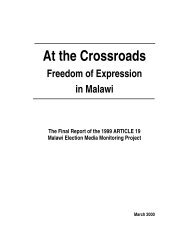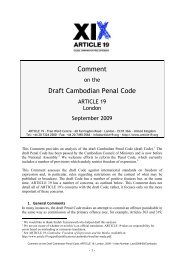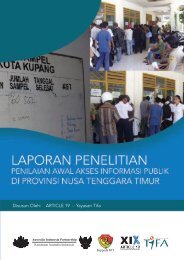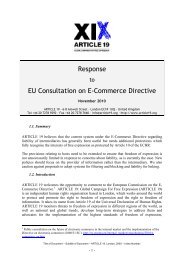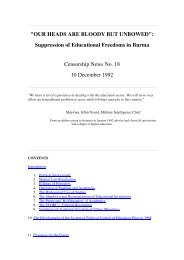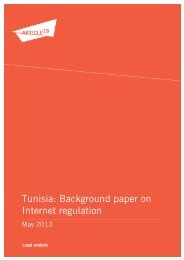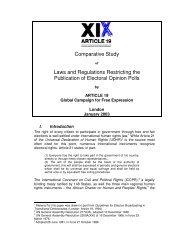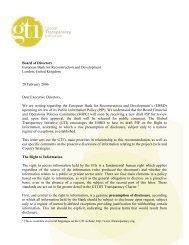FOR INTERNAL USE ONLY - Article 19
FOR INTERNAL USE ONLY - Article 19
FOR INTERNAL USE ONLY - Article 19
- No tags were found...
Create successful ePaper yourself
Turn your PDF publications into a flip-book with our unique Google optimized e-Paper software.
ARTICLE <strong>19</strong>GLOBAL CAMPAIGN <strong>FOR</strong> FREE EXPRESSIONBetween 2002 and 2006, nearly half of respondents judged environmental conditions to beunsatisfactory: ‘very unfavourable’ (on average 13%) or ‘unfavourable’ (35.4%). 32People’s assessment of their environment shows marked regional variance. In early 2006, thestate of the environment was assessed as ‘unfavourable’ by a quarter of people living in WesternUkraine, a third of the residents in Central Ukraine, nearly half (46%) of those living in the South, anda clear majority of people living in Eastern Ukraine (69%). The high percentage in Eastern Ukrainecorrelates with massive metallurgical and chemical production in the region, which unfortunately is inmost cases not accompanied by measures to protect the environment, and contributes to its steadydeterioration. Data for 2006 show that residents of the industrial East are most concerned about airpollution due to industrial chemicals, while residents of Central Ukraine tend to worry about radiation(38% in Kyiv). Yet, the most common concern recorded in all of Ukraine between 2002 and 2006 wasover pollution due to waste and litter. 33 Although the percentage of those who think that Chornobyl isthe principal factor impacting on their health decreased between 2001 (28%) and 2006 (17%), manystill see it as a ‘substantial’ factor. 34 Only 16% thought that other environmental issues had a greaterimpact on their health. 35 Serious concerns about the consequences of Chornobyl are not confined tothose living in the most contaminated areas of Kyiv, Zhytomyr and Chernihiv, but also include thoseliving in the more remote Vinnytsya, Sumy and Cherkassy oblasts. 36 According to the polls, healthhazards due to environmental conditions have been the second most frequently cited reason formigration over the past few years; only work prospects were a higher consideration.The majority of Ukraine’s environmental problems relate to its industrial activities. Thecountry inherited a vast industrial base from the USSR, when it produced more than a quarter of theUSSR’s industrial output. As a consequence, the country faces a number of industry-relatedenvironmental problems, including a large amount of obsolete pesticides and industrial toxic wastethat was created in the <strong>19</strong>70s. Ukraine’s ‘energy intensity’ is approximately 15 times higher than thatof the United States of America and is also higher than that of Russia. 3732 Some 23% were undecided. The rest thought that they lived in a ‘relatively favourable’ or ‘favourable’environment (the latter only in 2.4% of cases).33 According to the 2006 data, other concerns for Ukraine as a whole (in order of importance) are: exhaust gases,emission of chemical and industrial waste into the atmosphere, discharge of industrial chemical and industrialwaste into water, increased content of hazardous substances in foodstuffs, radioactive contamination, anddischarge of chemicals and industrial waste into the soil.34 On average 36.8% between 2001 and 2006.35 Approximately a quarter of respondents were undecided.36 Vinnystya is on the border with Moldova, Cherkassy is in Central Ukraine and Soumy is on the border withRussia.37 Environment and Security, the case of Eastern Europe: Belarus, Moldova, Ukraine, by the UN EnvironmentProgramme, UN Development Programme, UN Economic Commission for Europe, the Organization forSecurity and Co-operation in Europe, the Regional Environmental Centre for Central and Eastern Europe, andFor Internal Use Only. Is Post-Chornobyl Ukraine Ready for Access to Environmental Information?ARTICLE <strong>19</strong>, London, 2007+&



